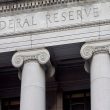by Lance Roberts, RIA
Fundamentally speaking, there are more than a few indications that 2022 earnings estimates are still overly exuberant. However, the bullish optimism currently supports rising stock prices. Such was a point I touched on in this past weekend’s newsletter:
“Overall, 56% of the companies in the S&P 500 have reported actual results for Q3 2021 to date. Of these companies, 82% have reported actual EPS above estimates, which is above the five-year average of 76%. If 82% is the final percentage for the quarter, it will mark with the fourth highest percentage of S&P 500 companies reporting a positive earnings surprise since FactSet began tracking this metric in 2008. In aggregate, companies are reporting earnings that are 10.3% above estimates, which is also above the five-year average of 8.4%.”
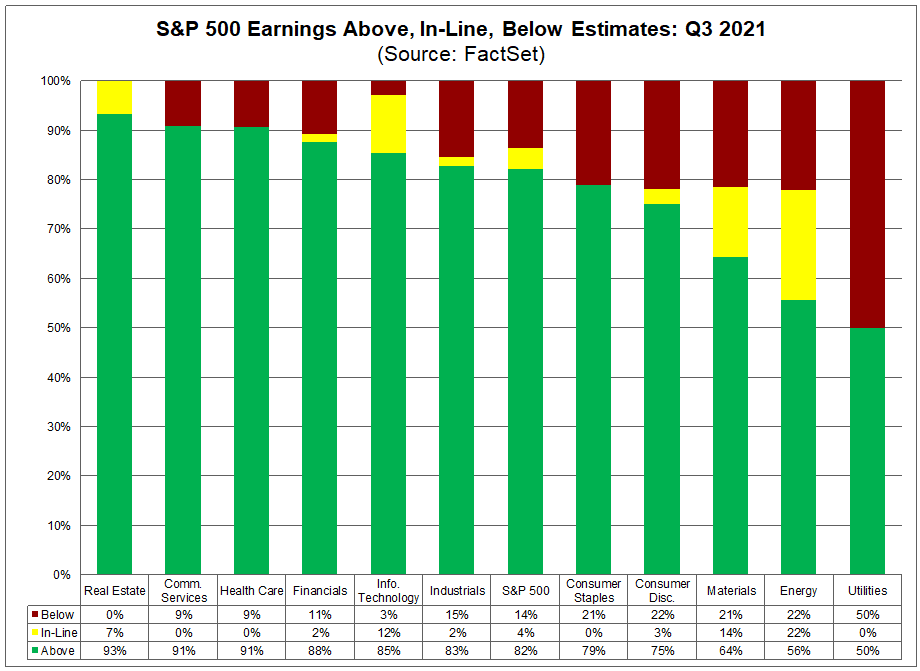
Earnings have indeed been impressive, but as we will discuss in more detail, this quarter will likely mark the peak of growth for a while. One particular reason is that while the outlook for earnings remains very bullish, economic growth and inflation trends are not.
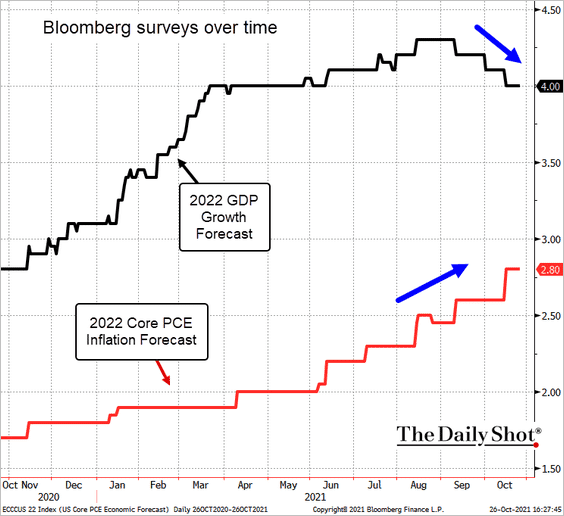
The problem for earnings is that weaker economic growth and rising inflation will weigh on profit margins.
Let’s start with economic growth.
Economic Growth Set To Weaken
In March of this year, I penned an article entitled “Sugar Rush,” wherein we discussed the economy would run “hot” and then “crash.” At the time, I received a lot of “pushback” on my “dire predictions” of economic growth later in the year. Furthermore, I followed that analysis asking if Q2 was the “Peak Of Economic Growth?” To wit:
“Was the second quarter the peak of economic growth and earnings? If estimates are correct and the year-over-year ‘base effect’ fades, such suggests risk to current earnings estimates. The chart from a “Grossly Defective Product,” utilizes the Atlanta Fed’s current estimates for Q2-2021 GDP. The full-year estimates are from JP Morgan. Notably, the economy quickly slows to 2% heading into 2022.”
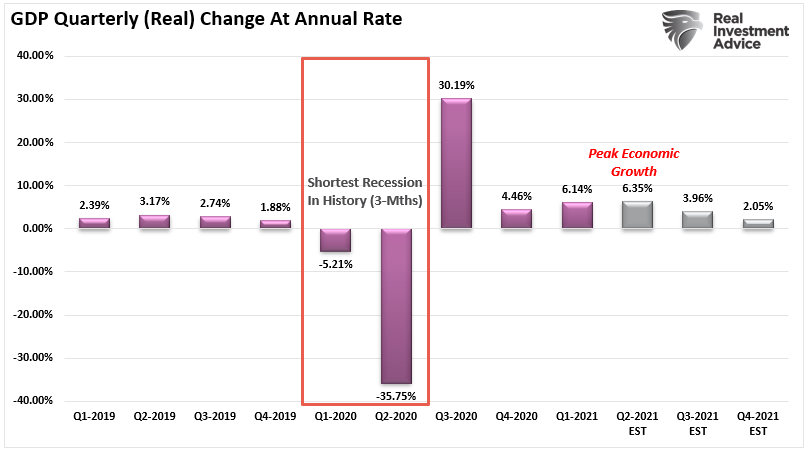
At that time, we estimated less than a 4% growth rate for the economy, with the Atlanta Fed well above 6%. Last Thursday, the initial release of Q3 GDP came in well below even our “bearish” expectations at just 2%.
Notably, the “advance estimate” is derived from a sampling of economists’ estimates. As actual data gets factored into the GDP calculation during the next two months, the growth estimates will get revised. But, as discussed in “The Bullish/Bearish Case,” the weakness in the economic data suggests those GDP revisions will be lower.
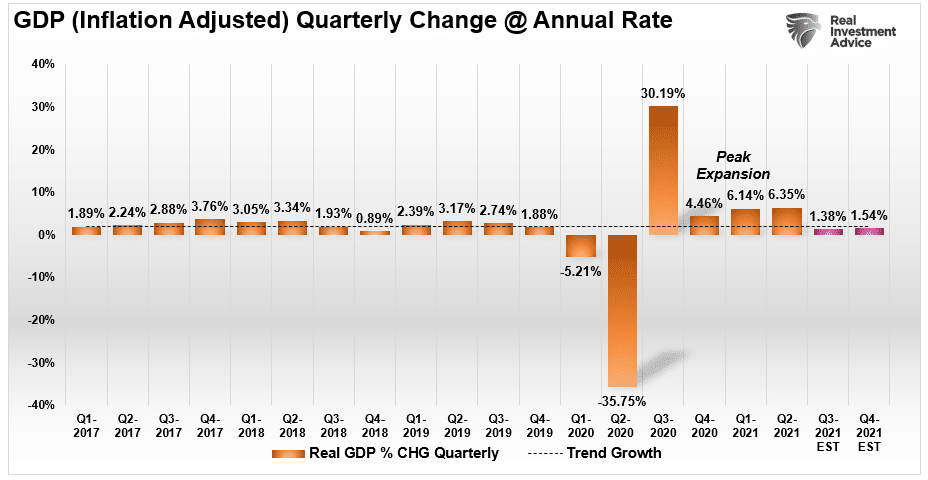
Economic Output Composite Index
We are confident in our assessment of weaker economic output due to our Economic Output Composite Index (EOCI).
The chart below is the Economic Output Composite Index. The index comprises the CFNAI, Chicago PMI, ISM Composite, the Fed surveys, Markit Economic Index, Markit PMI, NFIB, TIPP Confidence, and the LEI. In other words, this indicator is the broadest indicator of the U.S. economy there is.
The last complete set of data is through September. Notably, the index peaked at the second-highest level on record. When October gets fully accounted for, the index will decline further. Not surprisingly, there is a decent correlation between declines in the EOCI index and struggles for the financial markets.
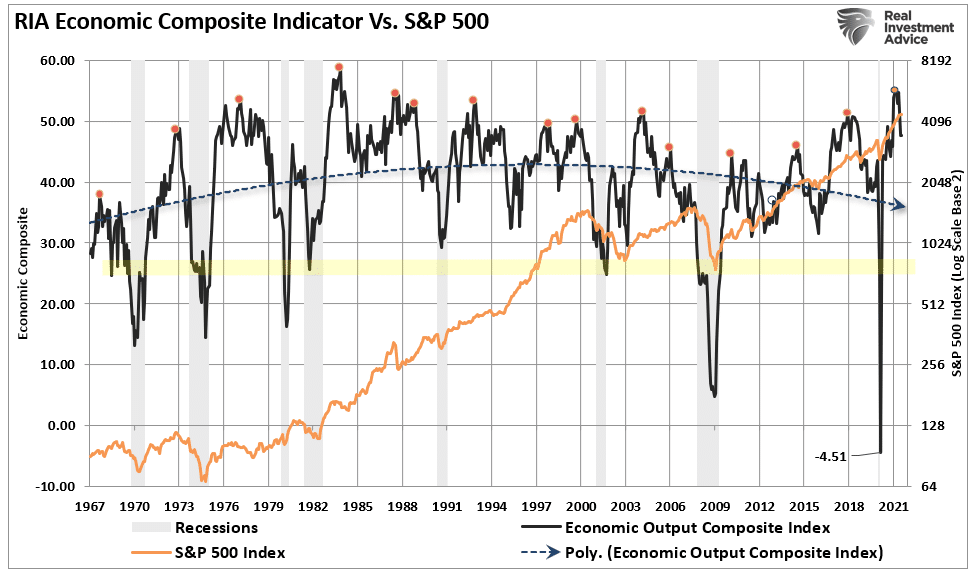
The implications of weak economic growth are broad. Consumer sentiment will remain weak as inflationary pressures undermine consumption. Furthermore, the negative impact on earnings continues to elude investors currently.
Earnings & Valuations Will Revert
There are two critical takeaways from the EOCI index. As noted, the stock market tends to correct, or worse, during reversals of the index. Secondly, there is a high correlation between the index and the annual change in earnings.

Such should not be a surprise given that “revenue,” which happens at the income statement’s top-line, is a function of economic growth. As individuals produce and consume, such is what creates economic activity. Revenues are a direct reflection of that activity. As economic growth slows, so does revenue.
However, this is a relationship investors have forgotten in their quest to push asset prices higher. Due to the massive liquidity infusions following the pandemic, equities have become increasingly expensive. As a result, equities are now the most expensive in history, measured by price to annual sales.
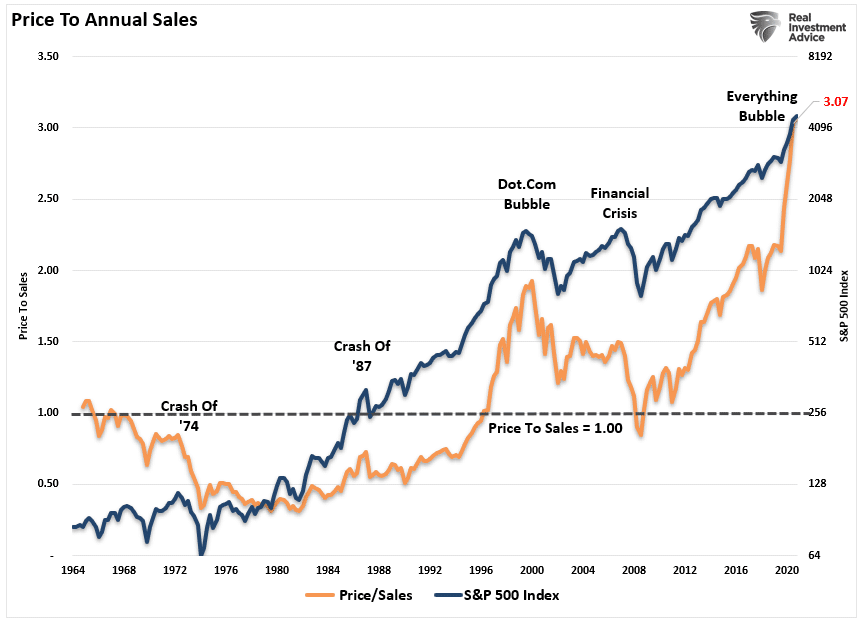
However, earnings per share, or what happens at the bottom of the income statement, are grossly manipulated through share repurchases, accounting gimmicks, and outright “fudging.” Therefore, top-line revenue gives us an accurate picture of the prices paid for stock ownership. Currently, investors are paying over 3x sales which exceeds any point previously.
Such is a point that should not get dismissed, given the long history of valuations and forward returns over the next decade. As shown, at 3x price to sales, expectations for 8% annualized returns should get lowered dramatically.
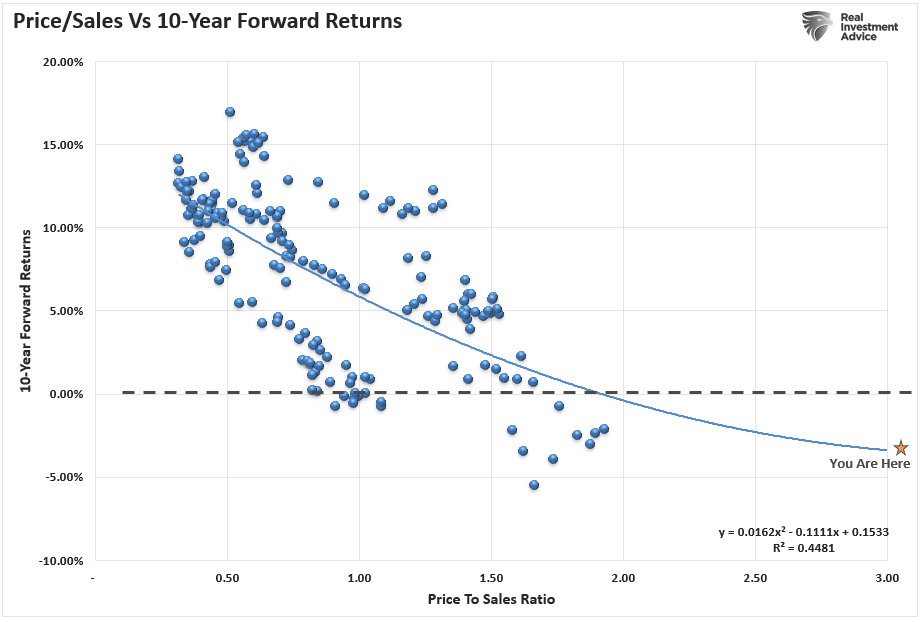
Analysts Are Overly Optimistic
“The biggest problem with Wall Street, both today and in the past, is the consistent disregard of the possibilities for unexpected, random events. In a 2010 study, by the McKinsey Group, they found that analysts have been persistently overly optimistic for 25 years. During the 25-year time frame, Wall Street analysts pegged earnings growth at 10-12% a year when in reality earnings grew at 6% which, as we have discussed in the past, is the growth rate of the economy.
This is why using forward earnings estimates as a valuation metric is so incredibly flawed – as the estimates are always overly optimistic roughly 33% on average.” – The Problem With Wall Street Forecasts
Once again, analysts have become exceedingly optimistic in their estimates.
Despite economic growth weakening as inflation increases, liquidity reducing, and profit margins under pressure, analysts continue to increase their earnings estimates. Currently, estimates for the Q4-2022 are $207/share according to S&P. As shown, that level will exceed the historical 6% exponential growth trend that contained earnings growth since 1950.
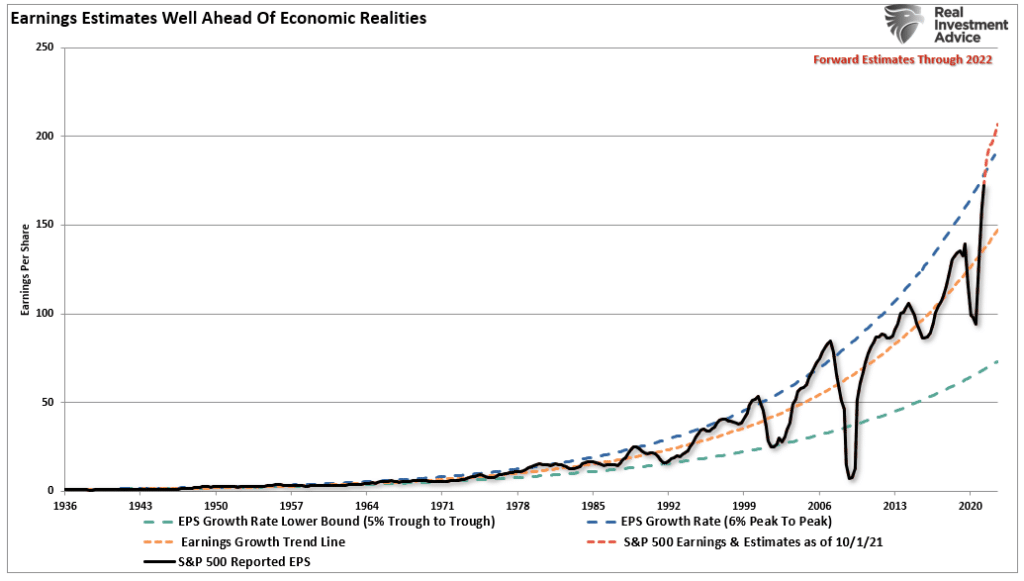
Currently, earnings expectations exceed the annual exponential growth trend by one of the most significant deviations on record. The only two periods with similar deviations are the “Financial Crisis” and the “Dot.com” bubble.

With analysts extremely exuberant, there seems to be little concern for investors. However, I would caution against such complacency.
As noted above, the most significant drivers to bottom-line earnings remain accounting gimmicks, share repurchases, and lower tax rates. However, there is a substantial risk to changes in the tax code, higher potential tax rates, and a reduction in liquidity. Such potentially threatens the critical drivers to profitability. As shown, revenue growth, as a percentage of the total, has shrunk to just 19% even though reported earnings per share surged by $2.74/share from repurchases.
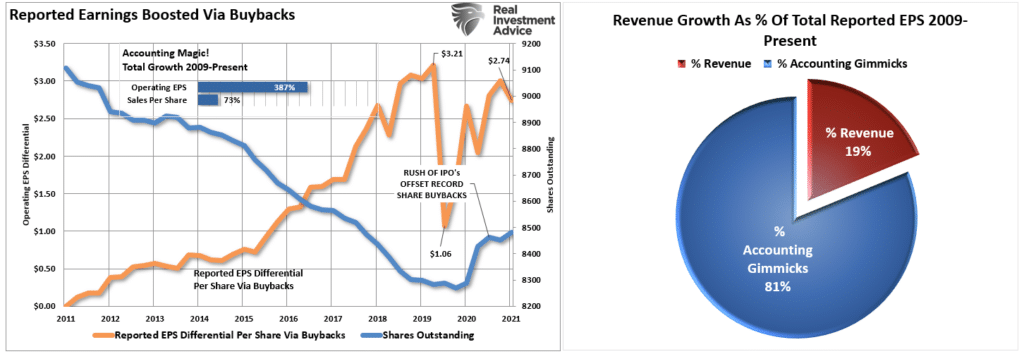
Conclusion
The “sugar high” of economic growth seen in the first two quarters of 2021 resulted from a massive deficit spending surge. While those activities create the “illusion” of growth by pulling forward “future” consumption, it isn’t sustainable, and profit margins will follow suit quickly.
The point here is simple, before falling victim to the “buy the market because it’s cheap based on forward-estimates” line, make sure you understand the “what” you are paying for.
Wall Street analysts are always exuberant, hoping for a continued surge in earnings in the months ahead. But such has always been the case.
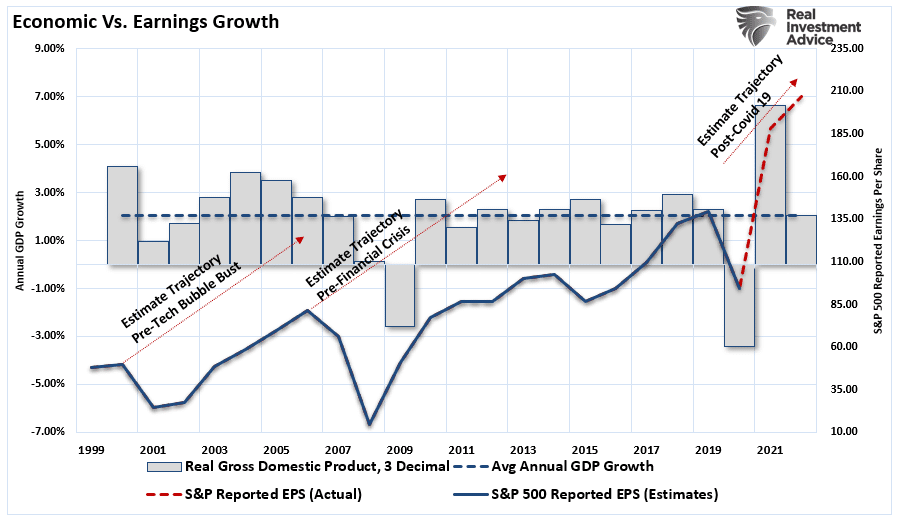
Currently, there are few Wall Street analysts expecting substantially weaker economic growth in 2022. But, unfortunately, there is a high probability such will be a reality, particularly as the Fed begins to “taper” bond purchases.
The risk to investors continues to rise as earnings peak and profit margins contract.
Wall Street is notorious for missing the major turning points of the markets and leaving investors scrambling for the exits.







